| |

No longer present in the western Atlantic, members of the genus Rhynchobatus can be found in shallow, warm (tropical and sub-tropical) waters of the eastern Atlantic, Indian and Pacific Oceans. They are bottom feeders which often school. Most species are less than five feet in length, and can be found in bays and estuaries feeding primarily on crustaceans. R. djiddensis is the giant of the family, reaching ten feet in length and five hundred pounds.
Bigelow & Schroeder (1948) do not discuss this genus, and R. djiddensis is an Indo-Pacific species. Cappetta's (1987) description is very similar to that of Rhinobatos. Members of this suborder retain more primitive (shark-like) characteristics than other batoids; the tail is still strong and both caudal and dorsal fins are present. These batoids tend to have a short snout, unnotched pelvic fins and small teeth forming a crushing dentition.
Stehmann (1981) Distinguishes the two guitarfish/wedgefish genera as follows:
Rhinobatos: "Caudal fin not bilobed; rear edges orf the pectoral fins extending to origin of pelvic fins or further; origin of first dorsal fin well posterior to rear tips of pelvic fins."
Rhynchobatus: "Caudal fin conspicuously bilobed, lunate in form, both lobes pointed; rear edges orf the pectoral fins falling short of origin of pelvic fins; origin of first dorsal fin over or slightly anterior to bases of pelvic fins."
Rhynchobatus djiddensis (WHITE-SPOTTED GUITARFISH )
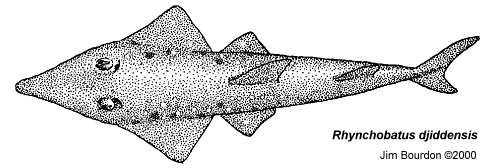
Rick Martin (SHARK-L, 7/30/98) provided the following synopsis of the species.
- Identification: pointed snout; first dorsal fin over pelvic fins; large black ocelli at base of pectoral fins; body colour tan to black, usually with distinct white spots on dorsum
- Range: South Africa to Red Sea, Japan to New South Wales, Australia
- Habitat: occurs in the surf zone, in estuaries, lagoons, and on sandy bottoms near coral and rocky reefs
- Depth Range: intertidal to at least 30 m
- Reproduction: of East Africa, males mature at a length of about 156 cm, females at about 177 cm; ovoviviparous; litter size 4 to 10; size at birth = 43 to 60 cm; birth occurs in summer in South African Waters; in some areas, birth occurs in estuarine habitats
- Maximum Size: 3.1 m in length, 220 kg in mass
- Feeding Biology: at high tide, swims onto reef flat to feed and find refuge; feeds on crabs,
lobsters, clams, and small fishes; some prey are excavated from the sand
- Comments: sometimes aggregates with roundnose stingrays (Himantura spp.) on reef flats at high tide; does well in public aquaria (kept for over 5 years); prized by sport anglers in southern Africa for its size and powerful fight when hooked
Dentition
On January 18, 1997 a dentition from the Tasmanian Museum was studied at the NJSM. TMD 2472 is from a 210 cm R. djiddensis (TL-K910843) female caught in Byron Bay, northern New South Wales (28S, 156E) on 5-25-91. The jaws measured c21 cm in width and 9.8 in height. Each dental band was c12 cm in width.
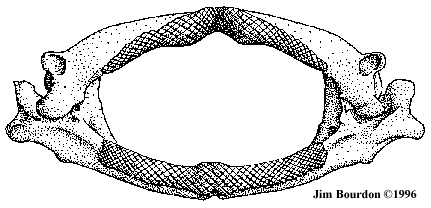 |
Fig. 2) Rhynchobatus djiddensis
Tasmanian Museum #D2472, 210 cm female |
 Upper dentition: 69 teeth, 34 columns right and 35 left, no symphyseal. The medial teeth are small (UL1 = 2.2 mm) in the depression, growing rapidly in the area of the bulge (UL11 = 4.2 mm) then diminishing (UL17 = 2.1 mm in width) before growing less rapdily (ULc27 = 2.4 mm) before again getting smaller. The distal column is 1.5 mm in width. Tooth row counts were: UL1 = 10, UL11 = 9, ULc27 = 7-8, UL34 = 6.
Upper dentition: 69 teeth, 34 columns right and 35 left, no symphyseal. The medial teeth are small (UL1 = 2.2 mm) in the depression, growing rapidly in the area of the bulge (UL11 = 4.2 mm) then diminishing (UL17 = 2.1 mm in width) before growing less rapdily (ULc27 = 2.4 mm) before again getting smaller. The distal column is 1.5 mm in width. Tooth row counts were: UL1 = 10, UL11 = 9, ULc27 = 7-8, UL34 = 6.
Lower dentition: 71 teeth, 34 columns right and 36 left, and a symphyseal. The medial teeth are large (LSym = 4.0 mm) on the bulge, dropping rapidly to (LR7 = 3.0 mm) then diminishing (LR9 = 2.7 mm in width) before growing less rapdily (LR16 = 3.5 mm) than again getting smaller (LR32 = 2.0mm). The distal (LR36) column is 1.5 mm in width. Tooth row counts were: LSym = 9, LL1 = 10, LL18 = 9, LL32 =13-14.

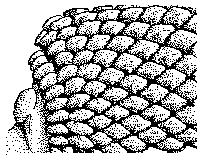 |
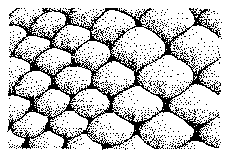 |
Fig. 3 Lower LH 29-36
illustrated width 12.5mm |
Fig. 4 Lwr RH 2, Sym, LH 1-7
illustrated width 14.0 mm |
Teeth
Teeth are generally densely packed. The last couple distal teeth are small and elongated. Strong lingual uvula and very weak or non-existant lateral uvulae. All teeth have a smooth and prominant transverse ridge. The lingual face and labial, anterior to the ridge, has weak pitting. Most teeth seem to have 2 to 3 foramina. The underlying design appears to be a central basal foramen and a lateral foramen on each lobe which connect with the openning on the root's lingual face. (UR2 has large lateral foramina which clearly penetrate each lobe to its interior face, UR6 has no apparent basal foramen.)
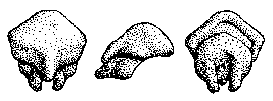 |
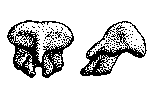 |
Fig. 5 Lower RH 5
hgt 2.0, wid 2.8, dep 2.8 mm |
Fig. 6 Upper RH 2
ht 1.9, wid 2.2, dep 2.5 |
|